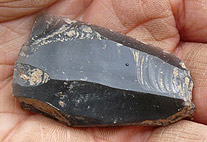Archaeological Site near Pulborough Provides Unique Evidence of Neanderthals
Neanderthals on the South Downs
An archaeological site located close to the small town of Pulborough on the South Downs may help provide evidence of how Neanderthals coped with conditions in England thirty-eight thousand years ago.
The extensive excavations are being carried out by researchers from the University College of London, digging trenches and cuttings to reveal tools used by hominids to hunt game such as Mammoths, Rhino and wild horses.
The site is located at Beedings Castle, a large country house. When it was being built over 100 years ago, workers discovered 2,300 flint tools, at first they were thought to be fakes and the vast majority were discarded with only about 200 being put into museum collections. Now an English Heritage funded project has enabled archaeologists to undertake a thorough examination of the site, using modern archaeological techniques. This is the first formal investigation since the site was discovered in 1900.
The Breedings Excavations
The Beedings excavations are important as they will provide further information to assist with the long-running study of the occupation of Britain by hominids (Ancient Human Occupation of Britain project). The finds in the West Sussex landscape also have international significance, the leaf-shaped cutting tools and other worked flints resemble similar tools find in other parts of Northern Europe. By comparing the different tools and the dates of the sites, researchers hope to gain an understanding of the development of stone use and flint cutting technology.
An Example of a Flint Tool from the Beedings Location

Picture credit: Pope/UCL
Neanderthals
The piece of flint in picture shows distinctive working with a number of facets exposed, evidence that this stone has been worked by a skilled hand, creating an effective blade. Many of the flints have distinctive leaf point assemblages. These are characteristic of a particular type of stone tool, believed to date from around 38,000 to 40,000 years ago (Lincombian-Ranisian-Jerzmanowician). It was during this period that Neanderthals and modern humans co-existed in Europe, there seems to be a shift in Neanderthal tool making techniques as they adopted some of the methods used by modern humans. Traces of Neanderthal art such as shell necklaces and other adornments have also been found in some European excavations. Cultural items such as non-functional items of jewellery are not known from older Neanderthal sites and some scientists have speculated that modern humans began to influence the Neanderthals in a number of ways, such as tool making and the use of adornments.
The Collecta prehistoric life mode range includes prehistoric mammals and Neanderthal figures: CollectA Prehistoric Life Figures.
The absence of any skeleton remains prevents the research team from being able to state with any certainty whether or not this site is associated with Neanderthals or modern humans H. sapiens. However, Dr Matthew Pope, one of the leaders of the expedition commented:
“It’s exciting to think that there’s a real possibility these were left by some of the last Neanderthal hunting groups to occupy northern Europe.” The impression they give is of a population in complete command of both landscape and natural raw materials with a flourishing technology – not a people on the edge of extinction”.
The Neanderthals began to decline in number with the migration of modern people into northern Europe. It has been estimated that within 10,000 of the arrival of modern humans the Neanderthals were all but extinct, with just small isolated populations left on the edge of the continent in Portugal. Neanderthals are believed to have died out just 28,000 years ago, a mere “blink” in geological time.
When the flints were first uncovered over a century ago, many were thought to be fakes and a large number were discarded, now scientists are beginning to realise the significance of this location. The elevation of the site would have made it an ideal vantage point to spot game, a notion not lost on the early hunters who worked tools on this strategic point in the local landscape.
The site was probably visited and occupied for many generations, an important location on what would have been one of the most northern sites of Neanderthal habitation, if indeed the site is proved to be associated with this particular hominid.
Finding Flints
The flints and other materials worked upon by these ancient hunters seem to have been sourced from local sandstone, this may provide the research team with clues of where to look for similar signs of Stone Age activity – strategic land points with stones for tool making accessible nearby.
Barney Sloane, the Head of Historic Environment Commissions at English Heritage said such sites were a precious archaeological resource.
“Their remains sit at a key watershed in the evolutionary history of northern Europe. The tools at Beedings could equally be the signature of pioneer populations of modern humans, or traces of the last Neanderthal hunting groups to occupy the region. This study offers a rare chance to answer some crucial questions about just how technologically advanced Neanderthals were, and how they compare with our own species”.
The Beedings dig site is a very important Early Upper Palaeolithic location, the large amount of flint work dating from the Palaeolithic but with some material from the more recent Mesolithic will provide the scientists with valuable information on the occupation of the United Kingdom by hominids.
West Sussex in England has proved to be a rich source of evidence regarding the evolution of hominids in Europe. A few miles to the south-west of Pulborough, close to the historic city of Chichester lies the small village of Boxgrove. It was here in a gravel quarry that evidence of an even earlier hominid was found – Homo heidelbergensis. A single massive tibia (shin-bone) dating from 500,000 years ago is the oldest record of a hominid in Britain, although recently found footprints in East Anglia (2014) have challenged this.


